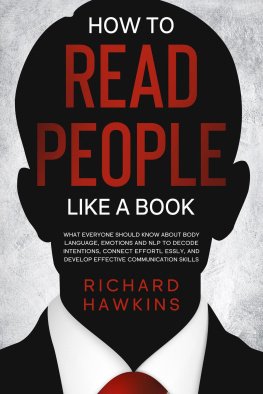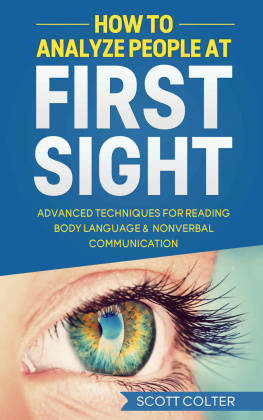Find Out What People Really Think, Even When They Lie. Anticipate Intentions and Defend Yourself Against Those Who Are Deceiving You Through Body Language
Copyright 2021 by Christopher Kingler - All rights reserved.
The content contained within this book may not be reproduced, duplicated or transmitted without direct written permission from the author or the publisher.
Under no circumstances will any blame or legal responsibility be held against the publisher, or author, for any damages, reparation, or monetary loss due to the information contained within this book; either directly or indirectly.
This book is copyright protected. This book is only for personal use. You cannot amend, distribute, sell, use, quote or paraphrase any part, or the content within this book, without the consent of the author or publisher.
Please note the information contained within this document is for educational and entertainment purposes only. All effort has been executed to present accurate, up-to-date, and reliable, complete information. No warranties of any kind are declared or implied. Readers acknowledge that the author is not engaging in the rendering of legal, financial, medical or professional advice.
Introduction

B ody language encompasses a variety of forms including facial expressions, gestures, eye movement, and posture. It includes voluntary facial expressions and gestures used to control the flow of interpersonal communication; it can also include control of bodily behavior that is not always conscious.
Body language is one of the three cues used in social interaction (besides speech and touch) and involves nonverbal communication between human beings. It can be used to express an emotion or thought, to manipulate others into feeling a certain way or simply to attract attention. Body language can serve functional purposes, such as to attract the attention of another person, to show interest in what another person is saying, etc.
It also serves social purposes, such as indicating a friendly or hostile attitude towards another person, indicating whether a person is comfortable with another, or showing ones attitudes about, or beliefs in something. It can also be used to advertise that one is looking for a sexual partner.
Body language involves the unconscious observation of natural human body movements such as gestures and posture. In this way, body language is a form of interpersonal communication. The term implies the existence of a range of communication which includes those acts that do not require speech. Body language is also sometimes known as kinesics from its early identification in the work of Dr. Meredith Regan in 1955. The field has become popular largely due to the efforts of famous experts such as Paver, Birdwhistell, and Mehrabian.
Body language can be more accurate than tone of voice in conveying a mood or attitude. Body language can be consciously controlled, but may also be the result of cultural or emotional conditioning. Body language is a form of nonverbal communication.
Body language exploits natural human cues and signals to display attitudes and intentions to others. It consists of facial expressions, hand gestures, posture, and eye movements.
The field of behavioral kinesics emerged in the 1920s as an offshoot of psychoanalysis. A part of psychoanalytic theory, body language was related to the study of mind or mental states. Sometime after World War II, social scientists and psychologists began to criticize the study of psychology, which ignored situational factors and environmental influences. This was the beginning of nonverbal behavior, the study of environmental influences on behavior. The new field proved useful in several ways:
As a result, manuals for law enforcement officers and security personnel emerged whereby they could learn more about preventing criminal activity, including how to identify subtle facial expressions or other body language cues that might help locate weapons or tell if a person was lying.
The American anthropologist Edward T. Hall was among the first scientists to study cross-cultural differences in nonverbal communication. He also developed one of the earliest theories of personal space.
Body language may be able to help people with autism spectrum disorders better express emotions and socialize in ways they can understand more than words alone.
Neurologists believe that humans are hardwired to control their bodies in certain ways. They suggest that this may be due to the existence of mirror neurons, which give people a sense of how others around them might feel during social interactions.
There are two categories of communication:
Verbal cues are communications that include spoken and written language.
Nonverbal communication : Can be observed through direct body contact or the lack thereof. While direct body contact, like holding hands or hugging, is an obvious example of nonverbal communication, the absence of direct body contact can also serve as a cue. For example:
Touch : is one method that can help let another person know how you feel about him or her. Touching of any kind serves several main purposes:
Touch may also be used as a form of communication to express affection or intimacy (e.g., hugging, hand-holding), or to indicate familiarity or friendship (e.g., a pat on the back). Touch, however, may also be used as a form of power and control (e.g., pushing someone out of the way).
Pace and proximity : This term refers to spatial relationships between people. People use these cues to determine how close they stand, and, consequently, how intimate an interaction is. When individuals are standing close to each other, it usually means they are comfortable talking to each other.
Proxemics : This is the study of human use of space. It describes personal space, social-cultural space, public spaces, intimate spaces, and others. An example of personal space is tending to feel uncomfortable or awkward when a stranger stands too close.
Gestures : Are nonverbal actions that communicate a message to another person without the use of words.
A gesture is understood within the cultural context it occurs in. For example, a thumbs-up gesture in the United States is understood to signal that everything is okay. In Brazil, Mexico, and other countries in South America, the same gesture signals an insult.
Gestures can be broken down into categories
Gestures can be grouped into several categories: greetings, distance-keeping behaviors, stances and poses, gestures of power or control, insults and obscenities, sexual gestures, and body decoration.
Nonverbal cues of discomfort may be communicated by different behaviors like facial expressions or physical actions that reveal emotions like sadness or anger.
While some bodily signals are universal, the context is essential to understanding them. A smile, for example, can mean "hello," or it can mean "I'm happy." It can also be a signal of embarrassment or discomfort. The context and the meaning must be interpreted to understand how that person actually feels.
Head and Facial Movements Are Used in Many Nonverbal Communication Cues
Head movements can indicate agreement or disagreement with what the speaker is saying. They can also be used to express the speaker's attentiveness towards the other person. Head tilts show attentiveness and interest, while a tilt to one side indicates inattentiveness or uncertainty. When nodding, there is usually a slight pause and no movement of the chin or facial muscles. This type of nod is used to indicate understanding, confirmation, or agreement.









